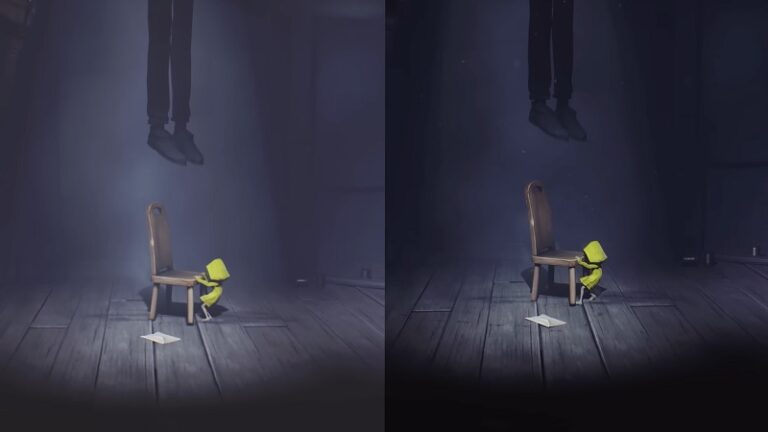
At long last, the moment this has seemingly all been leading to is finally here. What started as an earnest cry of ‘We Do it!’ back in 2015 has culminated in the third in a trilogy of modern remakes: 2023’s Resident Evil 4. It seems crazy to consider that a remake of such a beloved and objectively timeless experience would’ve been in the cards back then, but after completing Capcom’s reimagined take, it’s hard to picture it going any other way… or even wanting it to.
Six years have passed since the horrendous incident in Raccoon City, and our brave rookie cop Leon S. Kennedy has grown into a hardened special forces soldier working under the direct order of the President of the United States. When the new President’s daughter, Ashley Graham, is kidnapped by a mysterious organization, Leon is dispatched to search for her in a lonely and rural part of Europe — one that has become notorious for mysterious disappearances. What awaits him is a horrifying descent into hell as the locals turn bloodthirsty and mad, exposing the tip of an iceberg that will see us uncover one of Resident Evil’s most twisted chapters. While this all may sound familiar if you’ve already played the 2005 original, make no mistake — this isn’t just Resident Evil 4 but again, this adventure will be taking everything we know and love about the original and leaping off with it into uncharted territory.
From the word go, you’re thrown into a new and more vicious experience, a step above anything Resident Evil has done in a while, mechanically speaking. It’s easy to try and make comparisons to recent outings like Resident Evil Village because of a similar setting, but Resident Evil 4 Remake stands firm in two areas that separate it: tone, and weight.
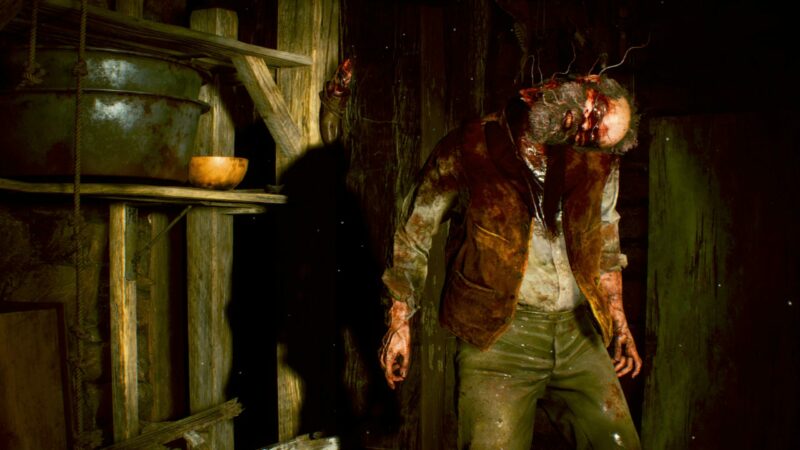
The original RE4, while spooky on occasion with a few frights here and there, doesn’t even come close to the creepy, grounded horror factor of this game’s tone. A new, haunting aura surrounds the revamped story and presentation that instantly creates a distinct horror experience that makes the original look like a jaunt through a spring field. While Las Plagas has appeared a few times in Resident Evil lore, never has it been presented with such a degree of genuine, uncomfortable body horror as in RE4 (2023).
Resident Evil 2 Remake‘s dismemberment returns, but this time reveals the full extent of the parasite’s hold over its hosts. Blasting these “people” apart exposes the Plagas’ true form, as it twists through these poor villagers’ bodies like writhing worms. A new emphasis on their “possession” under this nigh-alien invasion blight also highlights Los Illuminados, the resident cult, in a way that the original title wasn’t quite able to in my opinion. For the first time, the Ganado feel like zombies of their own breed; horrible puppeteered husks lacking the glint of soul behind their eyes as the nightcrawlers infest every inch of their flesh.
This tone extends beyond just the creatures players face, but into the world itself. The dilapidated Village, ominous Castle, and austere Island open up into disgusting and cluttered spaces that revel in that familiar REmake (2002) feeling of ‘realized reality’. Every inch drips detail and atmosphere and each new location delivers on the promise of what they represent. Originally, many locations lacked a certain ‘believability’, feeling more like video game arenas rather than functional spaces with designated purposes or logic. Resident Evil 4 Remake, like REmake before it, re-examines each of these areas and applies a new logic to them that makes for a much more immersive and enjoyable world overall.
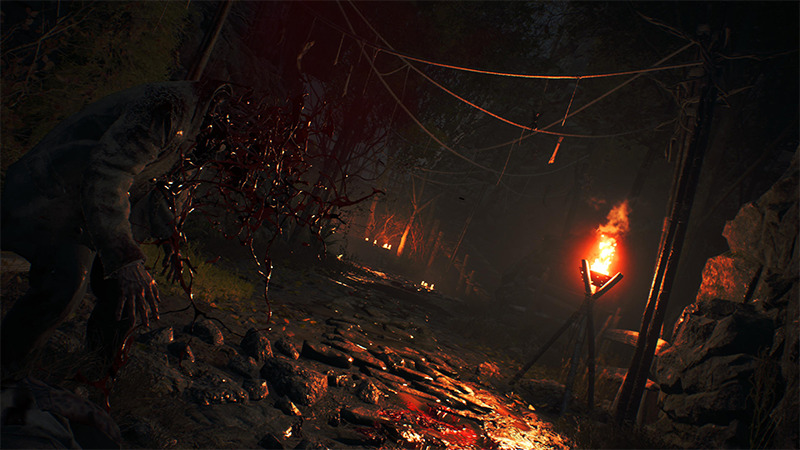
The village itself is my favorite location, as the strange pastures spiderweb into dark paths lined with twisted and mysterious alters to their “beliefs”, wrapped up in a cozy but intimidating fall atmosphere that establishes this game as delightfully Halloweeny in a way I hadn’t expected. Make no mistake, however, the Castle and Island are just as well crafted, even if separated noticeably in aesthetic, they still drip with this delicious tone.
Exploring these locations and fighting off these horrifying things is where the aforementioned weight comes in. The tank controls and locked-in aiming of yore are swapped out with faster, more versatile gameplay that sees Leon feel less like a walking gunship, and more like a vulnerable human, scrambling for safety against often overwhelming numbers. The original game’s generous I-frames (temporary invincibility) have been almost totally removed, giving Ganado the ability to gang up on you to deliver a series of quick, chained hits, wiping you out in seconds if you’re not careful. There is a give and take with this, however, as Ganado are now capable of damaging (and even killing) each other in ways they couldn’t before. A swing from a powerful enemy has just as great a chance of dismembering their friends as it does you.
Combat carries this weight through each encounter, as Leon’s arsenal matches up with the beating, slicing, and hacking of the oncoming creature feature as it surrounds us. Ganado swarm from every direction, forcing players to make faster and more panicked decisions, reinforced by the new parry mechanic.
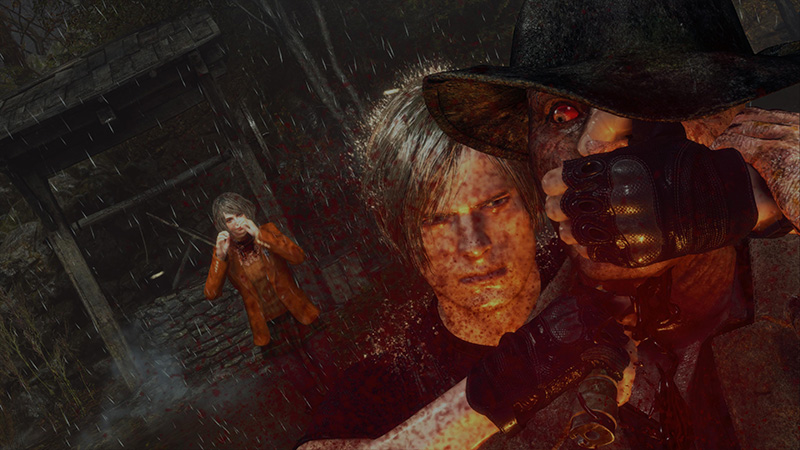
Every time an approaching enemy takes a swing at you, a window opens up offering Leon a chance to parry it with his combat knife. It’s not too difficult to pull off effectively after a bit of practice, but it’s also not a get-out-of-jail-free card. While your knife can save you from both damage and instant-kill attacks (such as from the famous chainsaw of the beloved Dr. Salavador), the knife is also limited in its uses. Another returning Resident Evil 2 Remake mechanic sees our knife come with a limited amount of useability, with each slash, stab, and parry eating away at its durability until the blade finally snaps in two. The knife can be repaired, but not by you (and you can also find small replacement knives, but they break even faster and for good) — forcing decision-making in the heat of combat. The call between parrying away damage vs leaving at least a little bit of the knife’s durability for fending off a fatal blow in the future is not always an easy one.
Comparisons could be made to Resident Evil 6‘s parry mechanics, but this new durability system results in a very different meta. RE6‘s combat parry was more about achieving perfect timing, and once mastered could potentially turn fights a little stale at best and child’s play at worst. When playing that game, I often found myself simply standing there, waiting for an enemy to attack in order to play out the cool animation as the only real drawback was potentially missing the QTE window and taking some damage. Here, however, that limited resource of your knife’s durability makes the choice to parry a frantic and often last-second one, forcing you to calculate future encounters by way of another tier of resource management.
Your knife’s durability informs other areas of the experience as well, as Leon now has access to stealth kills. While these can help thin out a horde before you’re spotted, this act too takes bits of your knife’s longevity away, quickly eating up what little you have for when the time comes to parry again. Another knife strategy is using it on foes that have collapsed to the ground, stabbing them in the jugular before they’re able to regain their footing. Some Ganado even begin to writhe in this state, as the Plagas leeches out of openings in its host’s head and neck, turning them into a faster and more dangerous threat. Again, is that ground takedown with the knife worth it to not have to face that, or do you not have enough knife durability left to risk it, and pray you have enough ammo to take care of the more advanced threat?
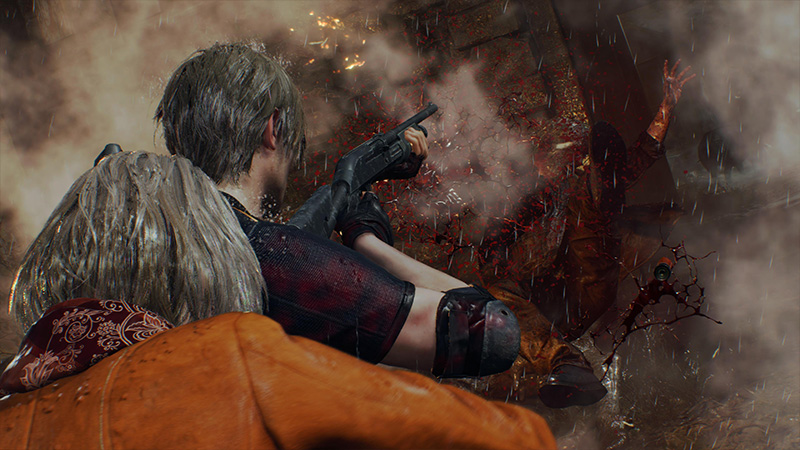
This is, of course, still Resident Evil 4, and enemies drop ammo, cash, and health upon death, and you can often find more by scrambling through the environment mid-fight to smash boxes and barrels. Rarely did I feel like I was becoming overloaded with resources, however, and I often found myself running from fights, as those resource drops often felt less like rewards, and more like saving graces. Each encounter has the potential to overwhelm you if you’re not careful, and getting overconfident can lead to sloppy decisions, which can lead to messy deaths. The weight of these skirmishes between the physical weight of Leon and his enemies, to the metaphorical weight of the decisions you’re forced to make on the fly, creates an intricate and delicate dance between survival horror and action that the series has attempted before but rarely managed to balance so cleanly. Fans of either or both will find a very fulfilling and engaging experience here.
Speaking of survival horror, an element I was surprised to see feature prominently throughout the entire game were puzzles. While the original Resident Evil 4 had a handful, they’re often mocked by fans for being relatively basic, with answers that were either too simplistic to be challenging, or so basic they were easily brute-forced. Resident Evil 4 Remake revamps a few of those old puzzles, but also completely replaces others, and even adds in a trove of entirely new brain teasers. These range from charmingly classic feeling survival horror fare to the surprisingly challenging, with one puzzle actually managing to stump me for upwards of ten minutes towards the game’s last quarter.
The last element of gameplay that sits right in the middle of all this is Leon’s rescue target, Ashley. Unlike the original, where she had her own health bar that needed managing and her AI was extremely limited, Ashley is now a more dynamic partner that feels more like a real person following you. She’s still a non-combatant, but rather than her original “wait” and “follow me” commands, now follows with commands to stick by Leon’s side (hovering close to him during combat or keeping step when exploring) or to give him more space (backing off and keeping a safe distance from the action). Ashley is much smarter now, scrambling to get out of the way of your shots and rushing to stay out of sight from the hordes.
While she no longer has a health bar, she can still get hurt; either by being knocked down by a powerful attack (from either an enemy or you if you aren’t paying enough attention) or grabbed and carried off. That knife comes back into play as you can use it to rush over and stab her kidnapper, but if it breaks (or has already broken) you’re left to risk opening fire, potentially hitting Ashley while trying to rescue her. If she’s knocked down, you’re gonna have to run over and help her up as well, as another hit will kill her.
Interacting with Ashley in the heat of combat is a good segue into the next part of Resident Evil 4 Remake‘s experience — the narrative.
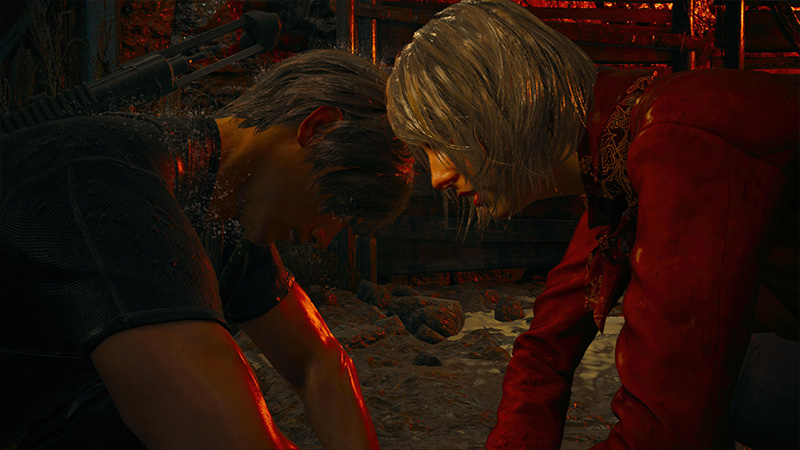
Despite the original game being one of my favorites of all time, it’s not difficult for me to say that its story isn’t… amazing. It’s not bad at all, but it’s far and away one of the campiest (or at least deliberately campiest) yarns in the series, with a story that just sort of throws things at you every few hours with little or no context, no real connections to past RE games (besides two characters that are so far removed from their origins they might as well be new ones), and a general light-heartedness that, while fun as hell, always sort of stood out in the series. Resident Evil 4 Remake uses this chance at retelling the story to retroactively turn it into a surprisingly character-focused and dramatic adventure that feels like a real sequel to Resident Evil 2 rather than a stand-alone, disconnected story that just happens to feature Leon.
Nearly every opportunity to embellish a character’s personality, backstory, or just general presence, Resident Evil 4 Remake takes. From Luis to Krauser, to especially Ashley, none of these characters have ever felt more complex or alive before, and I relished every single moment I had with them. New and returning fans will find plenty to love with these revamped takes on these old heroes and villains, and the way each character grows and informs Leon’s own character growth and vice-versa is some of the best in the entire series in my opinion. Leon and Ashley’s relationship sees the biggest boost, as modern sensibilities in game design now allow for them to chat in the brief moments between action, growing closer and understanding each other better. This helps elevate their interactions even more in cutscenes, leaving me very confident that the (in my opinion unearned) dislike for Ashley will be completely wiped out by the time the credits roll for fans.
Sadly, there is one character that was seemingly left out of this character upgrade magic — Ada Wong. I can’t/won’t explain too much, but I found that her character felt somewhat scaled back from the original, with much of her involvement noticeably less defined, and herself lacking in characterization. She hasn’t been ripped out of the story (as I’ve seen some on social media fear), but a blend of her voice direction (which is weirdly flat and distant) and many of her key scenes playing out with even less context than we were originally granted, I was very surprised by her implementation in this story.
Sorry to report, Separate Ways (a mini-campaign that focused on Ada’s half of the story) is not included with this release, but given this weirdness around Ada’s narrative and characterization, I suspect it’s deliberate; her real story and character growth may be being intentionally held off on for a Separate Ways story DLC, later on down the road. There’s a distinct feeling that elements of her story are missing, rather than cut.
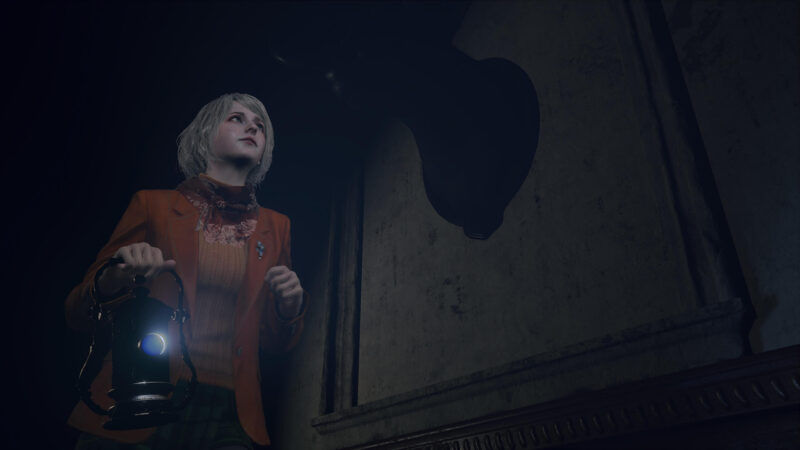
That does, unfortunately, lead to the next topic of discussion: cuts. Despite everything, this game does have a small (and I do mean small) handful of cut content, with the majority of them simply a sanding down of the very fringes of Resident Evil 4‘s edges. I personally found almost all of these cuts were negligible, but I feel I should still mention it for any fans that are worried (given skepticism following REmake 2 and 3‘s massive list of cut content). Resident Evil 4 Remake‘s ‘cuts’ come and go with barely a blip, feeling more like minor snips here and there rather than chunks of the experience being ripped out. There are also a few areas that are clearly meant to be locations from the original game but have been drastically reworked or reimagined in a way that I bet some fans won’t realize what they’re supposed to be, but I personally always felt that the reworking was an improvement.
I can’t go into any more detail than that unfortunately, but rest assured that this is not a repeat of past mistakes, simply a mild trimming of a handful of moments that results in a tighter and more cohesive experience. To be clear, none of these edits bite into the time it’ll take you to finish either, as this remake is easily one of the longest games in the series, rivaling that of the original title. My clear time was just two hours shy of my original 2005 playthrough (back when nobody even knew how to play this kind of game), and subsequent playthroughs have only just barely halved that time.
While we’re here, if I was to be forced to come up with any real negatives about the experience (beyond the aforementioned Ada weirdness), it honestly amounts to little more than nitpicks. The score, for instance, is largely great, bouncing back and forth between excellent ambient tracks that suit their areas perfectly and covers of original Resident Evil 4 tracks — but all-new action themes pop up here and there that honestly feel written for a completely different game. Heavy brass fanfare accompanies many of the more substantial fights that sound bizarrely out of place, with one, in particular, making me laugh out loud due to its similarity with Elliot Goldenthal’s score for 1995’s Batman Forever.
Other minor gripes include an odd lack of the “fade-out transparency” effect that many games use when objects obscure the area between the camera and player character, leading to (far and few between to be clear) moments where my aim would be temporarily obscured by an arrant tree branch or hanging chain. If any complaint comes close to ‘egregious’ however, it’s that the Hardcore difficulty mode feels oddly unbalanced, with a rocky difficulty curve that saw some fights ending in seconds due to how easy they were, while others (most notably one specific boss fight) feeling nearly impossible and taking a ridiculous amount of time to clear. Both of these issues may be resolved in the already announced day-1 patch, and are simply a result of me playing the early press build, but I still felt I should mention them just in case they make it into the final release.
Regardless, those are, again, minor nitpicks — and barely a blip on an incredibly solid and enjoyable gaming experience.
Moving on from “negatives”, Resident Evil 4 Remake boasts a surprising amount of all-new content, with each of the major locations (the Village, Castle, and Island) having been expanded into more ‘open-zone’ like areas that encourage both backtracking and exploration in a way that the original’s more straight forward and linear design didn’t even come close to. These new elements aren’t a replacement for older ones either, but rather add new environmental tissue between the original locations to create a series of small sandboxes for you to play in and explore. It’s amazing, and I genuinely hope none of you dear readers get spoiled for just how wild some of it can get. Believe me when I say: y’all aren’t ready for some of the stuff waiting for you in this game.
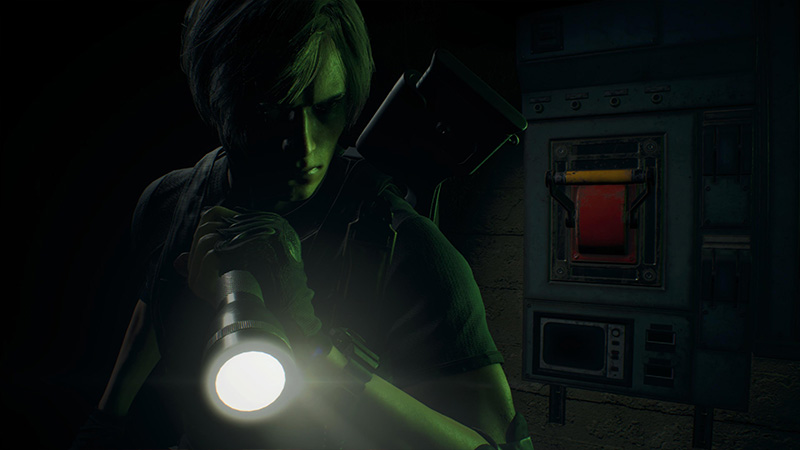
With the robust story and character enhancements, small snips, and overhaul to exploration, that isn’t to say that this remake throws the original away when doing any of that either. Indeed, this experience clearly revels in its love for the classic. From the word go, you’ll find a mixture of the startlingly new and delightfully familiar, as Resident Evil 4 Remake mixes nostalgia and revamp in a way that neither of the previous two remakes did, creating a perfect blend that kept a smile on my face for my entire playthrough. The new and more natural dialogue is peppered with lines directly from the original 2005 script (as can be seen multiple times in the demo already), music and sound effects are punctuated with familiar samples, and subtle (and sometimes not-so-subtle) nods here and there culminate into creating a feeling of celebration, rather than an attempt to replace. Returning players who have adored what made the original what it was will find plenty here to fawn over to be sure.
From the story, to the presentation, to the moment-to-moment gameplay, Resident Evil 4 Remake delivers on everything it sets out to accomplish, and then some to be frank. There’s so, so much more to talk about honestly, but they’re best saved for you to discover for yourself. There were moments that had me cheering, had me grinning with bright-eyed glee, and even a moment or two that had me tearing up (yes really) from beginning to end, and left me satisfied as hell. Having played it all the way through multiple times by the time of writing, it’s safe to say that this is absolutely a new, modern classic that is destined to become part of my yearly replay roundup. I’ve got nothing left to say, except — bingo.
 (9.5 / 10)
(9.5 / 10)
Amazing
 (9.5 / 10)
(9.5 / 10)Rely on Horror Review Score Guide
PlayStation 5 review code provided by the publisher

